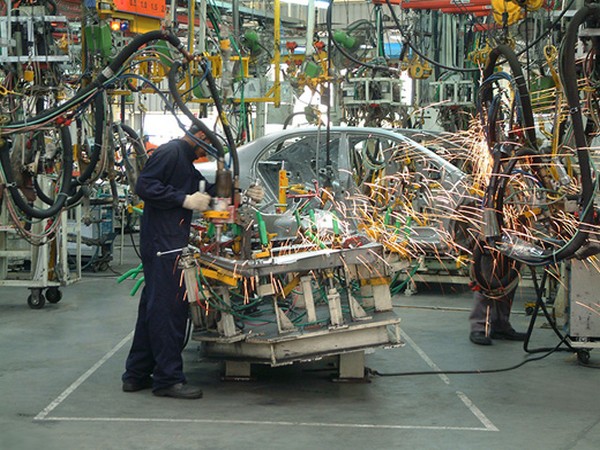
New Delhi: As the iconic lion logo of Make in India, crafted from interlocking gears, completes its tenth year of symbolizing India's industrial prowess, the nation stands at the cusp of a manufacturing revolution.
Prime Minister Narendra Modi introduced this massive project on September 25, 2014, and since then, it has not only been a government programme but also a wake-up call that has changed both the way the world views India and its economy. The intent was very clear: to establish India as a Centre of the world's manufacturing, attract investment, encourage innovation, and create jobs.
With the help of this extensive program, India's economy has the potential to grow at the quickest rate in history, greatly stimulating local industry and enhancing the country's reputation as a top location for investments. The numbers tell a compelling story of success. The manufacturing sector, which contributed a modest 16% to India's GDP in 2014, has grown to account for over 17% in 2024, and is expected to reach 25% by 2030.
India’s rise as a global manufacturing hub is vividly illustrated by the transformation of key regions be it in the bustling industrial corridors of Gujarat’s GIFT City and Tamil Nadu's emerging semiconductor hub. A striking example is Noida’s growth into a mobile manufacturing powerhouse:
Mobile phone manufacturing units surged from just 2 in 2014 to over 200 by 2024.
Production escalated from 60 million units in 2014-15 to 3.1 billion units in 2022-23.
India transitioned from being a net importer to becoming the world’s second-largest mobile phone manufacturer.
Driven by policy reforms and strategic initiatives under the Make in India program, India is steadily working towards its objective of raising the percentage of manufacturing in GDP to 25%. Major international companies in a variety of industries, including electronics, textiles, defense, and automobiles, have been enticed to locate their manufacturing facilities in India by this campaign. Due to the country's strong labor pool, advantageous location, and alluring government incentives, corporations such as Foxconn, Samsung, Boeing, and Hyundai have increased their operations in India.
The success of Make in India was recently emphasized by Commerce and Industry Minister Piyush said that India is becoming known throughout the world as a leading location for investment and industry. Companies from all over the world are keen to set up shop in India for manufacturing across a range of industries. As a result, India is becoming a major player in the global market in addition to being a favored location for manufacturing for domestic purposes.
Key milestones of make in India
The total amount of foreign direct investment (FDI) received between April 2000 and March 2024 was $990.97 billion, shattering previous records while the total FDI inflows received in the last 10 years (Apr 2014 to Mar 2024) was $667.410 Bn which amounts to nearly 67% of total FDI inflow in last 24 years, demonstrating India's rising attraction to foreign investors.
Job creation has been another transformative achievement. With the employment increased by nearly 36%, adding around 170 million jobs during 2016-17 and 2022-23, India's economic trajectory demonstrates sustained job creation across key sectors.
A more investor-friendly climate has also been fostered by the government's dedication to enhancing the ease of doing business. More than 3,500 compliances have been decriminalised, simplifying more than 40,000 compliances and allaying concerns about civil prosecutions.
India’s new industrial landscape
As Make in India continues to reshape the country’s industrial landscape, several key sectors have witnessed remarkable transformations, fueling economic growth and global competitiveness.
The MSME Sector, which is often referred to be the foundation of India's economy, is one of the notable success stories. Millions of small and medium-sized businesses have been empowered by the launch of programs like the Udyam site, which had over 4.7 crore registrations by July 2024, and a sharp spike in loan flow.
In a similar vein, defense manufacturing has made a huge breakthrough, moving from reliance on imports to export leadership. India's defense exports increased dramatically to ₹21,083 crore in FY2024, with a growth of 32.5% over the FY2023 at ₹15,920.
The Production Linked Incentive (PLI) Scheme has grown to a pillar of India's industrial policy, is a crucial component of Make in India 2.0. The PLI project, which has a staggering ₹1.97 lakh crore ($26 billion) allotted to 14 important sectors, is predicted to provide an astounding ₹3.35 lakh crore in output by 2025–2026. Large-scale investments have been drawn to this project, which has helped establish India as a hub for global manufacturing in sectors including electronics, automobiles, and medicines.
Innovation and technology
The manufacturing industry has undergone a technological revolution with the Make in India initiative. India is now recognized as a leader in digital manufacturing, with majority Indian enterprises having implemented Industry 4.0 technologies by 2023. By 2025, it is anticipated that India's industrial Internet of things (IoT) industry would open more doors to more intelligent and productive production techniques.
A number of business titans have established standards for utilizing technology to improve productivity.
Government initiatives fostering innovations
The Indian government has implemented several programs to foster manufacturing innovation, with a particular focus on digital transformation. The Digital India Program has established centers for Industry 4.0 (C4i4) labs across the country, supporting advancements in digital manufacturing. Additionally, the Department for Promotion of Industry and Internal Trade (DPIIT) has actively funded manufacturing-focused startups under the broader Startup India initiative, encouraging entrepreneurship in the sector.